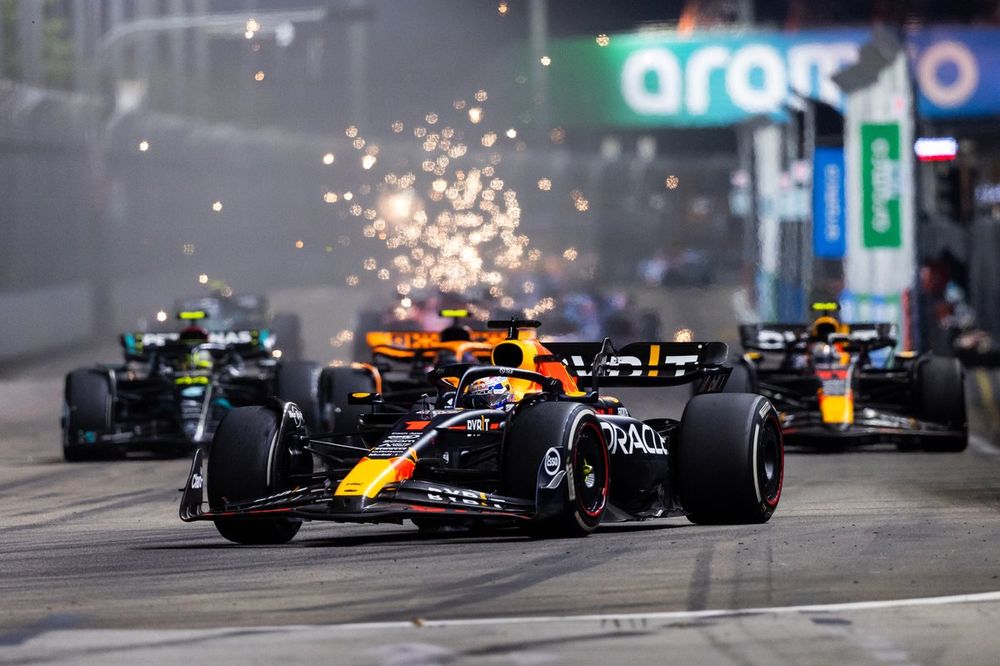
As the RB19s rolled out for FP1 on Friday, it swiftly became apparent that the cars had fallen out of their hitherto very wide operating window. Max Verstappen called his ride “undrivable” as he lacked confidence when hitting the brakes only to then turn in and find wayward cornering balance.
With Red Bull finally looking impeachable, comparisons were soon made to the 2015 visit to Marina Bay when the street circuit chewed up and spat out dominant force Mercedes. Back then, the team that had won 10 of the first 12 races amid its new-found 1.6-litre turbocharged hybrid dominance departed the circuit with Nico Rosberg only fourth and Lewis Hamilton having retired.
ANALYSIS: 10 things we learned at the 2023 F1 Singapore Grand Prix
Mercedes could not definitively explain its lack of competitiveness that weekend. Hamilton fell victim to a boost pressure problem following a clamp failure but even before then, both W06 machines struggled to generate tyre temperature. Of the remaining six races that season, the Silver Arrows scored a 1-2 in five of them. Singapore proved to be little more than a bizarre blip.
Rosberg supposed that the problems were circuit-specific. And the same is expected to be true for Red Bull, especially given team principal Christian Horner is adamant that two FIA Technical Directives clamping down on flexi-wings and flexi-floors hadn’t impact his cars at all.
Asked to explain the dip, after Verstappen ran only 11th fastest in qualifying as Sergio Perez was 13th, Horner said: “It's all engineering stuff. There are no silver bullets in this business. I know all of you would love to blame the TD but unfortunately, we can't even blame that. It's not changed a single component on our car… zero.”
Instead, it was Singapore’s outlier nature that threw a spanner in the works. The RB19 has proved so strong thanks to an ability to hold a predictable aerodynamic platform. This results in consistent behaviour through different corner profiles. The secret to this is excellent ride control, whereby the car can run low at high speed to maximise the downforce-producing ground-effects.
But to cope with the bumpy Singapore street circuit, the first sector of which was laid with new asphalt, and its tall kerbs, the cars had to be raised. It is understood that compensating for these extremes lifted the RB19s out of its wide operating window.

That tallies with Verstappen and Perez having to back off through Eau Rouge in the Belgian GP earlier this year to avoid bottoming out too much. The car suffers at bumpier venues.
Red Bull was coy on its issues. Chief engineer Paul Monaghan pointed to “inherent problems” with the chassis. But Dan Fallows, technical director of Aston Martin following his stint as Red Bull head of aerodynamics, supposed: “It’s a track where you have quite a unique style of corners. And even with the changes this year, where we've got rid of two of the chicanes, there are still a lot of corners which are quite short in duration.
“It tends to be quite bumpy in places and also kerb-riding is quite important in these cars. So, you tend to have to run the cars maybe higher than at other circuits as well. That has, in the past, been an incredibly unique challenge for some cars. Certainly, I think Red Bull are the most obvious example of that.”
For 2023, a revised lap configuration also served to upset the established order. Removing the fiddly Turn 16-19 chicanes eliminated key traction zones to shift the circuit further towards Ferrari by mitigating its tyre degradation shortcomings, even if the team has shown gains of its own in this area since the summer break.
Singapore also upset Aston Martin. While the Silverstone squad has fallen behind in the development race, and some have linked this to the clamp down on flexi-parts, a turbulent race for 15th-placed Fernando Alonso was worse than expected. The AMR23 had threatened to take pole position and victory in Monaco. But the car seemed lost at sea for the next time F1 stopped at a street circuit.
Unlike Aston, however, Red Bull did appear to resolve its issues as the weekend wore on. While parc ferme regulations came into effect after Q1, tyre pressure and wing tweaks helped significantly come the race. Verstappen (eventually fifth) and Perez’s (eighth) race pace was behind only the Mercedes drivers - who were favoured in this respect by bolting on fresh mediums for a rapid final stint.
As such, rivals are convinced that Singapore was an off-weekend only for Red Bull. As it was for Mercedes eight years ago also. Toto Wolff said: “If you ask Red Bull why they didn’t get it right, I am sure they don’t know. It is a variable of these ground-effect cars - they are very difficult to set up [if] you fall out of the window of performance and that has happened to us more than we have got it right.
“I think Singapore has always been an outlier as a track. Just because they dropped the ball here doesn’t mean that going back to a conventional circuit, Suzuka especially, it means there’s a pretty good chance the normal pecking order will come back.”







